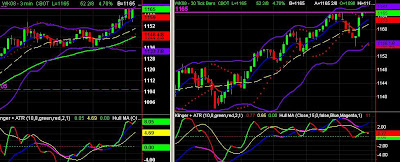This is important for America to understand. At the same time that grain futures prices are skyrocketing, prices for livestock are plummeting. Look at these two charts for Feeder Cattle (upper chart) and Lean Hogs (lower chart):
 Why The Dichotomy?
Why The Dichotomy?
At the same time that the prices of corn and other grains that feed livestock are going up like a mushroom cloud, why are prices for livestock plummeting?
I have posted these two charts above because I want to display graphically the phenomenon that is occurring. As can be seen in these two charts, prices for lean hogs and feeder cattle are plunging at the same parabolic rate as grains prices have been rising. Because it is too expensive to continue feeding the animals at current grain prices, ranchers are being forced to sell their livestock and send it to slaughter much sooner than planned. The cost to feed the animals is rapidly escalating, and rather than face bankruptcy by continuing to feed them, they are disposing of the animals. With so many animals being prematurely sent to slaughter, futures prices for pork and beef are plunging downward. Wholesale buyers are having a bonanza, buying the younger animals and reducing their input costs, increasing their profits (we're not seeing cheaper beef or pork at the grocery store, are we?).
So why should we care?
Because in about 12-14 months' time, the number of livestock animals in the United States will be significantly fewer, and then, meat prices will soar for two reasons:
- Grains prices will go even higher still, as the number of animals on feed increase back to normal levels, further increasing upward price pressure on corn and other feed grains.
- Fewer livestock animals available for meat production now will increase the price (lower supply + same demand = higher prices) for them later (lower supply leads to higher prices later) and will drive prices for hogs, poultry, and cattle futures through the roof.
 All of this is the terrible consequence of a badly misguided government policy of turning food (corn, soybeans, sugar) into fuel (ethanol). The only people who will ultimately benefit from this fiasco are the politicians! Meanwhile, America continues to slide toward energy oblivion!
All of this is the terrible consequence of a badly misguided government policy of turning food (corn, soybeans, sugar) into fuel (ethanol). The only people who will ultimately benefit from this fiasco are the politicians! Meanwhile, America continues to slide toward energy oblivion!












































